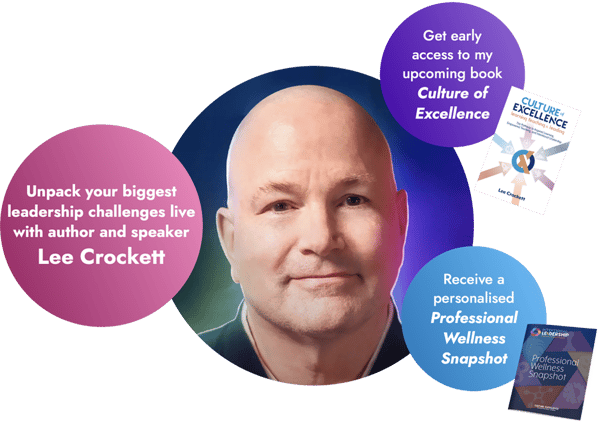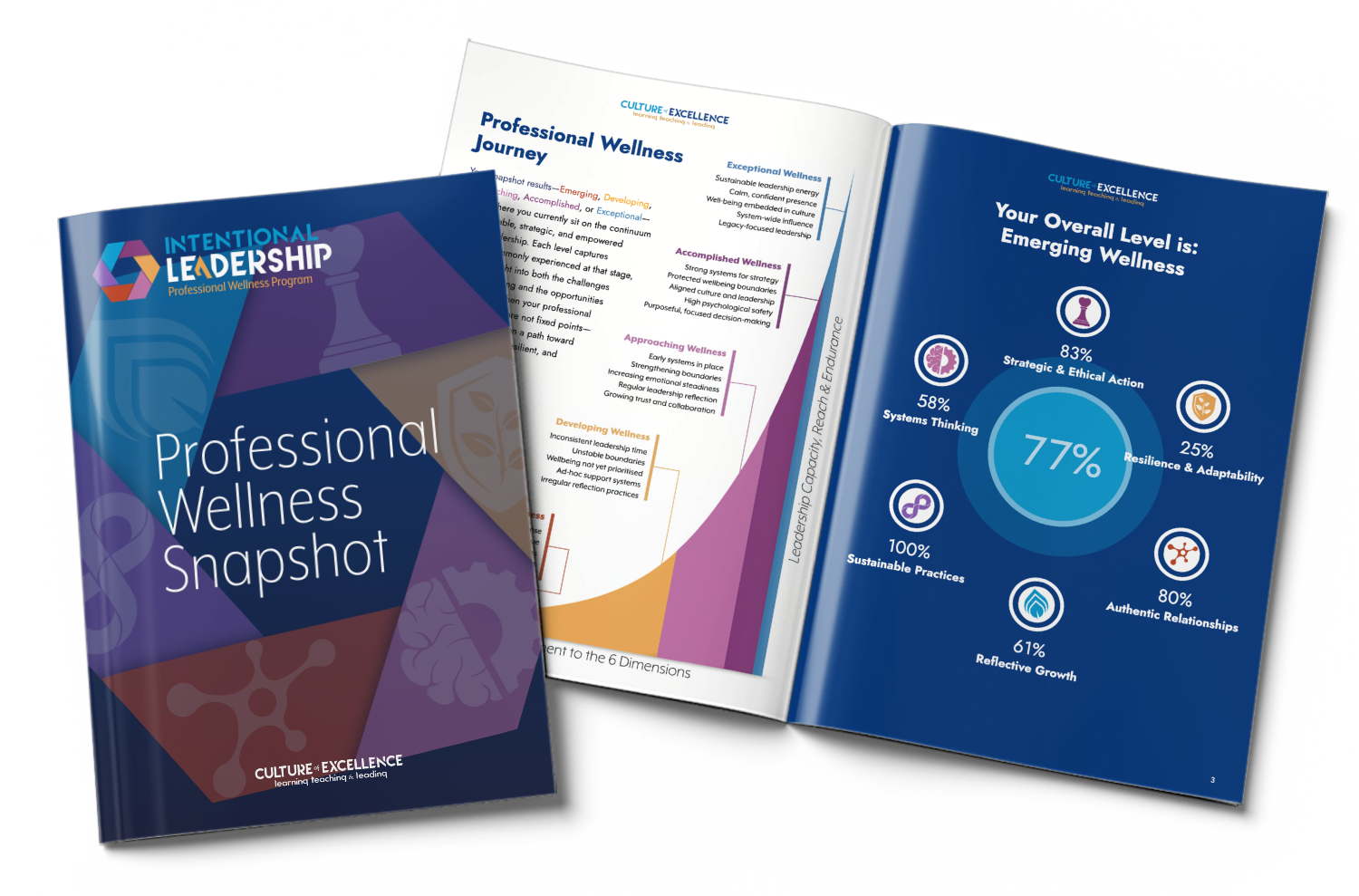
The Myth of the Natural Leader
Why confidence doesn't equal capacity
This video challenges the romanticised idea of the “born leader” and shows how that belief quietly undermines real development. School leaders don’t need to be perfect—they need to be growing. And the moment we start treating leadership as a craft, everything changes.
What part of your leadership have you felt pressure to “just know”—instead of permission to learn?
Want to Lead With Steadiness—Not Strain?
Join our FREE Professional Wellness Workshop—a live session where we explore all six dimensions and help you refocus on what really sustains school leadership.

The Myth of the Natural Leader
Why confidence doesn't equal capacity
"They called me a natural leader. But no one taught me how to survive it."
I hear this line—or some version of it—all the time. From school principals, deputy heads, and certainly emerging leaders who stepped into complex roles not because they were trained, but because they were seen as ready.
They’re confident. Trusted. Calm under pressure. So they’re promoted—fast. And once they’re in?
- The coaching stops
- The learning disappears
- The expectation becomes: “You’re a natural—you’ve got this.”
But leadership isn’t something you’re born with. It’s something you build. And the myth of the “natural leader”? It’s quietly holding some of our most promising people back.
The price of praise
We confuse potential with preparation, and it’s costing us. People who show promise are expected to perform. Those who lead with presence are assumed to be invincible. And when things start to crack, we wonder why they didn’t speak up sooner. This isn’t just unfair—it’s unsustainable.
It’s part of the larger pattern I explored in Leadership in Triage, where the system conditions leaders to survive but never breathe. We reward those who appear steady, but rarely ask how much they’re holding—until they buckle. Also, in Glorifying Overwork, I unpacked how exhaustion became a measure of dedication. But sometimes it’s not just about working too much.
It’s about performing leadership to meet the expectations that come with that "natural" label. We nned to talk about what happens when potential becomes the reason we stop supporting the very people we promote. Here are three truths I’ve seen dismantle the myth of the “natural leader”.
Truth 1: Being called “natural” often leads to isolation
One of the most capable deputy principals I’ve worked with was widely respected. When her principal retired, she was offered the role immediately. No onboarding, and no mentoring—just a hallway handshake and the keys to the office. Within weeks, she was managing complex staffing issues, major cultural shifts, and systemic pressure to perform—alone.
“Everyone said I was born for this,” she told me. “But I’ve never felt more alone.”
This is the shadow of the “natural leader” narrative. Once you look competent, support disappears.
Leadership isn’t something you’re born with. It’s something you build.
As I described in The Emotional Tsunami, many leaders don’t even realise how much they’re absorbing until they reach a point of emotional depletion. That depletion doesn’t come from lack of skill—it comes from leading without insulation.
The result isn’t failure. It’s quiet retreat. And we never question it—because from the outside, they looked fine.
Truth 2: Overperformance is often a mask for undersupport
In another school, I coached a deputy whom everyone relied on. She managed staff conflicts, behaviour incidents, parental engagement, and scheduling. She was composed, competent ... and quietly burning out.
When we sat down, she said, “I’ve built a version of myself that looks like I’ve got it all together. But I’ve never actually had time—or permission—to grow.” She was performing capability, not developing leadership.
In Glorifying Overwork, I called this the "professional performance loop"—where people are praised for their output, not their clarity. And in some systems, that output becomes the price of being taken seriously. This kind of overfunctioning is particularly common in education. And it’s especially pervasive among women and minoritised leaders, who are often expected to “prove” their readiness repeatedly, without meaningful development opportunities (Santamaría & Santamaría, 2015).
Overperformance isn’t proof of readiness. It’s often a symptom of being under-supported.
Truth 3: Leadership isn’t a trait—it’s a craft
During a leadership retreat, a principal confided, “After the week I’ve had, I’m questioning whether I’m even good at this.”She’d had a rough staff meeting, a difficult conflict including a moment where she didn’t respond the way she wanted to.
I asked, “If one of your teachers had a rough lesson, would you assume they’re not cut out for the job?” She shook her head—of course not. We don’t treat teaching that way, and we don’t treat learning that way. But we treat leadership like an identity; something you are, or you aren’t.
Many leaders don’t realise how much they’re absorbing until they reach emotional depletion.
As I shared in The Emotional Tsunami, when we frame leadership as a personality trait, people internalise the pressure to never get it wrong. They mistake vulnerability for failure—and stop growing altogether. Leadership isn’t a personality, it’s a practice.
The most effective leaders I’ve seen are the ones still learning, questioning, and reflecting in motion. But that kind of growth only happens when systems are designed to support it.
Let’s retire the compliment that became a cage
Calling someone a “natural leader” may sound like praise. But it often becomes the excuse to:
- Withdraw support
- Skip coaching
- And assume growth will happen on its own
That’s not how excellence is built. You don’t need to be born for this. You need space to learn, constructive and insightful feedback, mentorship, and tools, not just trust. So, to that end, let’s normalise asking for help. We must stop pretending leadership is innate. Instead, let’s honour it for what it really is: a discipline that deserves to be developed.
Want to build leadership that lasts?
This is exactly what we explore in the Professional Wellness Workshop—a free space I’ve created for school leaders who want to lead with clarity, confidence, and support that actually sticks.
When you register, you’ll also receive an advance copy of my new book:
Culture of Excellence: The Path to Empowered Teaching, Inspired Learning, and Intentional Leadership
What’s one leadership skill no one taught you—but you had to learn the hard way?
References
Day, D. V., Fleenor, J. W., Atwater, L. E., Sturm, R. E., & McKee, R. A. (2014). Advances in leader and leadership development: A review of 25 years of research and theory. The Leadership Quarterly, 25(1), 63–82.
Goleman, D., Boyatzis, R., & McKee, A. (2013). Primal leadership: Unleashing the power of emotional intelligence. Harvard Business Press.
Hochschild, A. R. (1983). The managed heart: Commercialization of human feeling. University of California Press.
Leithwood, K., Azah, V. N., Harris, T., Slater, C., & Jantzi, D. (2020). Principal leadership and teacher wellbeing: The role of trust, equity, and capacity. Educational Administration Quarterly, 56(5), 746–784. https://doi.org/10.1177/0013161X20952858
Maslach, C., & Leiter, M. P. (2016). Burnout: A multidimensional perspective. In R. J. Burke & C. L. Cooper (Eds.), The fulfilling workplace: The organization’s role in achieving individual and organizational health (pp. 77–96). Routledge.
Santamaría, L. J., & Santamaría, A. P. (2015). Culturally responsive leadership in higher education: Promoting access, equity, and improvement. Routledge.

Not Sure What's Holding You Back?
Take our quick 2-minute Professional Wellness Snapshot to pinpoint where your biggest barrier lies—and which leadership dimension to strengthen next.